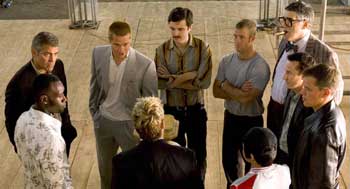
Abbas Kiarostami has always had an experimental streak, but he's never indulged it as far as he does in Five which consists of opening credits and five long shots of nature. That's it. For each shot, Kiarostami points his video camera at the ocean or a reflection of the moon in a pond, and he holds it for 10 or 15 minutes. A few seconds of music open and close each segment, which otherwise sounds like water lapping the beach, frogs croaking, or thunder in the distance. And each segment, after saying its piece, fades to black or white.
And you know what? It's a nice piece of work. It's the kind of movie that succeeds when you're willing to let your mind wander the way it does when you watch clouds. Maybe you'll close your eyes and just listen for a bit. Maybe you'll nod off. I doubt if Kiarostami would object; he even said once that he enjoys movies that are so calm they make you sleepy but give you something to reflect on later.
Of course Five may also raise the ire of would-be hecklers in the audience. Kiarostami has some gall to show the beach for 10 minutes! Anyone could do that! I suppose that's true, but it doesn't lessen the worth of spending a few minutes watching the waves. Some folks may think the film is pretentious, I guess, but I'm always saddened by the narrow box that movies are expected to fit into. When I go to a bookstore I see thousands of books on thousands of subjects written in thousands of different styles, but the movie theater in the very same mall feels like a bookstore where someone has torched everything but the mysteries, sci-fi novels, chick lit, and comic books.
No, Five doesn't fit into those categories. It has no story, although it has some humor and maybe even something that could be considered suspense. It's like a book of nature photography, although of course these pictures move, they have sound, and, maybe most importantly, they advance at a pace that you can't control. You can't rush past the piece of driftwood on the beach. You'll have to watch it for a while.
The full title of the movie is Five: Five Long Takes Dedicated to Yasujiro Ozu, which is confounding since nothing in the popular Japanese filmmaker's body of work is even remotely like this. Nevertheless, since Kiarostami planted the idea in my head with his opening title, I thought of Ozu as I watched the driftwood sitting on the beach. Gradually the tide rises enough to nudge the wood, and it breaks into two pieces, the larger of which is carried away by the waves. In Ozu's Late Spring, a father and daughter are riding on a streetcar when the young woman steps off to go shopping. Ozu could follow her or he could stay with the father as he continues on to work. Ozu chooses the daughter, and so his camera gets off the streetcar with her. Kiarostami chooses the small chunk of wood and stays with it on the beach. But the large chunk isn't gone. A few minutes later it comes back into view — the hand-held camera moves slightly so we can see it floating a few yards offshore — just as the father and daughter remain in the same world even though they separate when the daughter gets off the train, and again later when she gets married.
Was Kiarostami thinking of Late Spring when he made Five? If he was, one of us is psychic. But the joy of an open-ended movie like this is what you bring to it.
In another segment, ducks run past the camera. Did Kiarostami encourage them to run? How much did he manipulate what we're seeing? Did he shorten the final segment's thunderstorm in the editing room or is it really so brief? Were the sounds recorded at the pond or somewhere else? Isn't it interesting how the ocean waves confuse the camera's auto-focus mechanism, blurring the picture when they roll in and sharpening it when they recede, as if they're able to manipulate the machine without even touching it?
I wouldn't want Kiarostami to abandon narrative filmmaking forever, but Five is a welcome diversion. It's refreshing to see a filmmaker of his stature throw caution to the winds. You could liken Five to recent albums by Wilco and Radiohead that boldly resist the narrow box of pop music. Filmmakers might even deserve a longer leash than pop musicians if only because they get less time in our lives. Pop music works through repetition, and even Wilco and Radiohead need to make songs that we'll listen to again and again. But most movies are seen once. They get precious few chances to plant something in your head, and I can think of far worse things to stick in your brain than five contemplative shots of nature.


